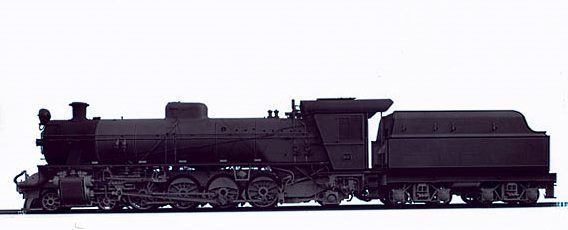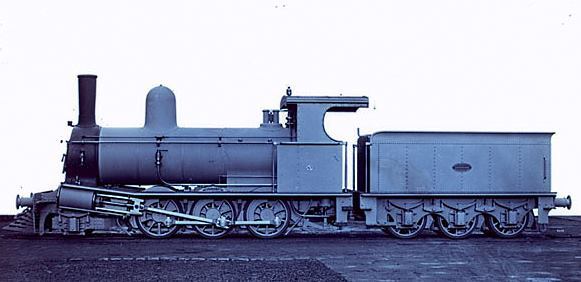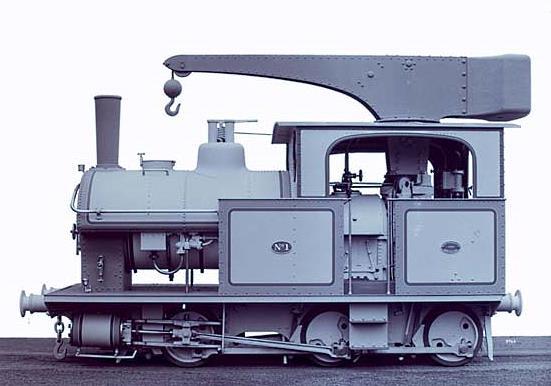Beyer Peacock in Australia
In a time when global communications relied on mail carried by sailing ships it was almost impossible for any business to have a global impact but one British engineering company, Beyer Peacock & Co. of Manchester England, managed to do just that.
From Japan to South Africa and Chile to Norway there is not one region or continent that Beyer Peacock & Co. didn’t reach with their railway locomotive business. The company even managed to sell at least one of their steam locomotives into mainland USA; quite a feat for a market that was totally dominated by companies such as Alco, Baldwin and other home-grown companies.
Here in Australia Beyer Peacock & Co. sold steam locomotives to every Government owned railway system and to quite a few private companies too and those locos ranged from simple 0-4-0 tram locos to huge articulated locomotives that, for a time, where the most powerful steam locomotives in the southern hemisphere.

This 914mm gauge 0-4-0T locomotive (b/n 2043) was delivered to the Mount Bischoff Tin Mining Company in Tasmania in 1880.
Beyer Peacock was also able to tap into the more modern Australian locomotive market with the 40 locomotives that made up the NSWGR’s 46 Class.
But what should be counted?
It seems to me that deciding on what should be counted as being built by Beyer Peacock is not rocket science. If it was built in the Beyer Peacock factory then it should be counted as a product of that company and perhaps we should also count those locomotives that were built under license by other manufacturers when Beyer Peacock simply couldn’t keep up with the demand.
Yet there are some experts who feel that it’s important to differentiate between “normal” locomotives and articulated locos even if the articulated locos were built in the Beyer Peacock factory. Those experts don’t seem to be concerned if some of those locos were built under license.
So you will find that there are lists of Beyer Peacock products that exclude articulated locomotives and other lists that only include articulated locomotives.
However a list that covers covers both “normal” and Beyer Garratt locomotives is more meaningful and that’s what I produced here with the list of Beyer Peacock locomotives of all types that came to Australia.
Two interesting pieces of trivia
However, before we do look at a list that covers articulated and non-articulated locomotives produced by Beyer Peacock, it’s interesting to note that if we only look at non-articulated locomotives then Queensland was the state that purchased the least number of steam locomotives from Beyer Peacock.
The various state government systems purchased 919 non-articulated locomotives from Beyer Peacock & Co but only two of those were purchased by Queensland Railways. Those two were two 0-6-0T crane locomotives (b/n 4317 and 4318) purchased in 1902.
The second interesting piece of trivia concerns the Commonwealth Oil Corporation which operated a standard gauge line that ran from their mine at Newnes in the Wolgan Valley to a junction on NSWGR’s main western line at Newnes Junction. While I was researching this article I came across a drawing that was produced in 1908 for a proposed 0-6-0+0-6-0 Beyer Garratt locomotive.
The drawing number was 72538 and it was marked as being prepared for the Commonwealth Oil Corporation.

No. 37 was part of an order for 7 2-4-0 locos placed by the Victorian Railways in 1861. These were b/n 231-237. Obviously something was removed from the photo but that seems to have been done during the production process.
Who bought what:
Victoria
Victoria was the first state system to place an order with the company when they placed an order in 1861 for seven 2-4-0 locomotives. Victoria went on to purchase:
1 x 2-4-0
13 x 0-6-0
1 x 4-4-0T
10 x 4-4-0
20 x 4-6-0
and
2 x 2-6-0 + 0-6-2 2’ 6” gauge Beyer Garratt locomotives.
The last order the Victorian Railways placed with the company was in 1925 and covered the two narrow gauge articulated locos.
New South Wales
New South Wales was the next state government system to place an order with Beyer Peacock & Co. In 1865 they placed an order for nine 2-4-0 locomotives and this order was to be the first of many with the final tally for steam locomotives supplied by the company reaching 574.
New South Wales’ purchased:
3 x 2-2-2
1 x 0-4-0 tram
2 x 0-4-2T Crane
13 x 2-4-0
12 x 2-4-0T
28 x 4-4-0
6 x 4-4-0T
15 x 4-4-2T
63 x 0-6-0
70 x 2-6-0
106 x 4-6-0
12 x 2-6-4T
95 x 4-6-4T
141 x 2-8-0
and
42 x 4-6-4 + 4-6-4 Beyer Garratt locomotives
South Australia
The South Australian Railways placed their first order in 1869 when they ordered two 1600mm gauge 2-4-0T locos on order 2319.
Surprisingly the last order Beyer Peacock received from the South Australian Railways for conventional locomotives was in 1889 when an order was placed for 14 1067mm gauge 2-6-0 locomotives.
It wasn’t until 1953 that the South Australian Railways went back to Beyer Peacock with an order for 10 1067mm gauge 4-8-2+2-8-4 Beyer Garratt locomotives and this order was passed to Societe Franco-Belge
The South Australia Railways purchased:
4 x 0-4-4WT (1067mm gauge)
11 x 2-4-0T (1600mm gauge)
4 x 4-4-0T (1600mm gauge)
2 x 0-6-0 (1600mm gauge)
18 x 0-6-4T (1600mm gauge)
89 x 2-6-0 (1067mm gauge)
and
10 x 4-8-2+2-8-4 (1067mm) Beyer Garratt locomotives

This handsome locomotive was part of an order for 40 4-8-2 locomotives placed by the West Australian Government Railways and delivered in 1951 (b/n 7378 to 7417)
Western Australia
West Australia placed their first order for Beyer Peacock locomotives in 1882 when order 6237 was placed for two 2-6-0 locomotives. The final order from West Australia was placed in 1955 when an order for 24 2-8-2 locomotives was subcontracted to R Stephenson and Co.
The West Australian Government Railways purchased:
10 x 2-6-0
2 x 4-6-0
24 x 2-8-2
60 x 4-8-2
and
13 x 2-6-0+0-6-2 Beyer Garratt locomotives

Over the years Beyer Peacock delivered 27 2-6-0 locomotives to the Tasmanian Government Railways. While the TGR often placed orders for multiple locomotives this particular loco was supplied on an order for just 1 locomotive. This locomotive (b/n 2509) was delivered in 1884.
Tasmania
The Tasmanian Government Railways first order for locomotives from Beyer Peacock came in 1884 when order 6449 was placed for one 2-6-0 locomotive. The last order that the Tasmanian Railways placed with Beyer Peacock was in 1912 when orders 0303 and 0304 were placed for four Beyer Garratt locomotives.
The Tasmanian Government Railways purchased:
5 x 2-4-2T
23 x 4-4-0
27 x 2-6-0
2 x 4-6-0
and
2 x 0-4-0+0-4-0 (610mm) Beyer Garratt locomotives
2 x 4-4-2+2-4-4 Beyer Garratt locomotives
2 x 2-6-2+2-6-2 Beyer Garratt locomotives

One of the two locomotives that were the first order the QGR placed with Beyer Peacock
Queensland
The Queensland Government Railways were the last government system to place an order with Beyer Peacock.
Their first order, placed in 1902, was for just two 0-6-0ST Crane locomotives and the QGR didn’t go back to the company with another order until 1950 when an order was placed for 10 4-8-2+2-8-4 Beyer Garratt locomotives
Queensland’s final orders were placed in 1951 when more 4-8-2+2-8-4 Beyer Garratt locomotives were ordered in two batches. These 20 locomotives were subcontracted to Societe Franco-Belge.
Queensland Government Railways purchased:
2 x 0-6-0ST Crane locomotives
and
30 x 4-8-2+2-8-4 Beyer Garratt locomotives
Beyer Peacock also supplied a number of private railway companies, timber companies, mining companies and contractors with locomotives that ranged from simple 0-4-0T shunters right up to 4-8-2+2-8-4 Beyer Garratt locomotives.
Private Railways
My research suggests that Beyer Peacock built and exported at least 106 locos for non-government railways in Australia and a separate overview of those locomotives will appear eventually.
While a number of Beyer Peacock locomotives have been preserved it has been many years since any ran in revenue service in Australia.
Bibliography
Beyer Peacock Website: beyerpeacock.co.uk. Beyer Peacock Production List V1 04.08.02
Beyer Peacock Website: beyerpeacock.co.uk. Beyer Peacock Locomotive Order List, Garratt Locomotives, Customer List V1 04.08.02
All photos courtesy of: Museum of Science & Industry/Science & Society Picture Library, UK